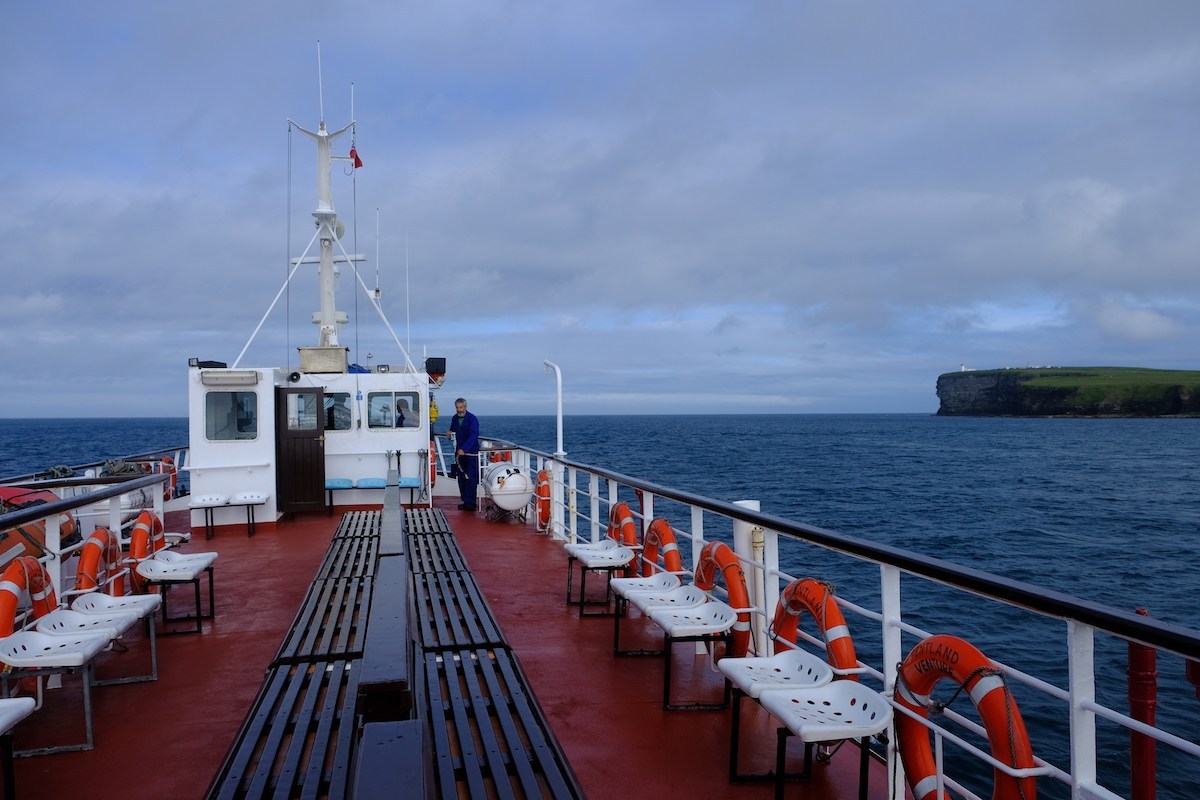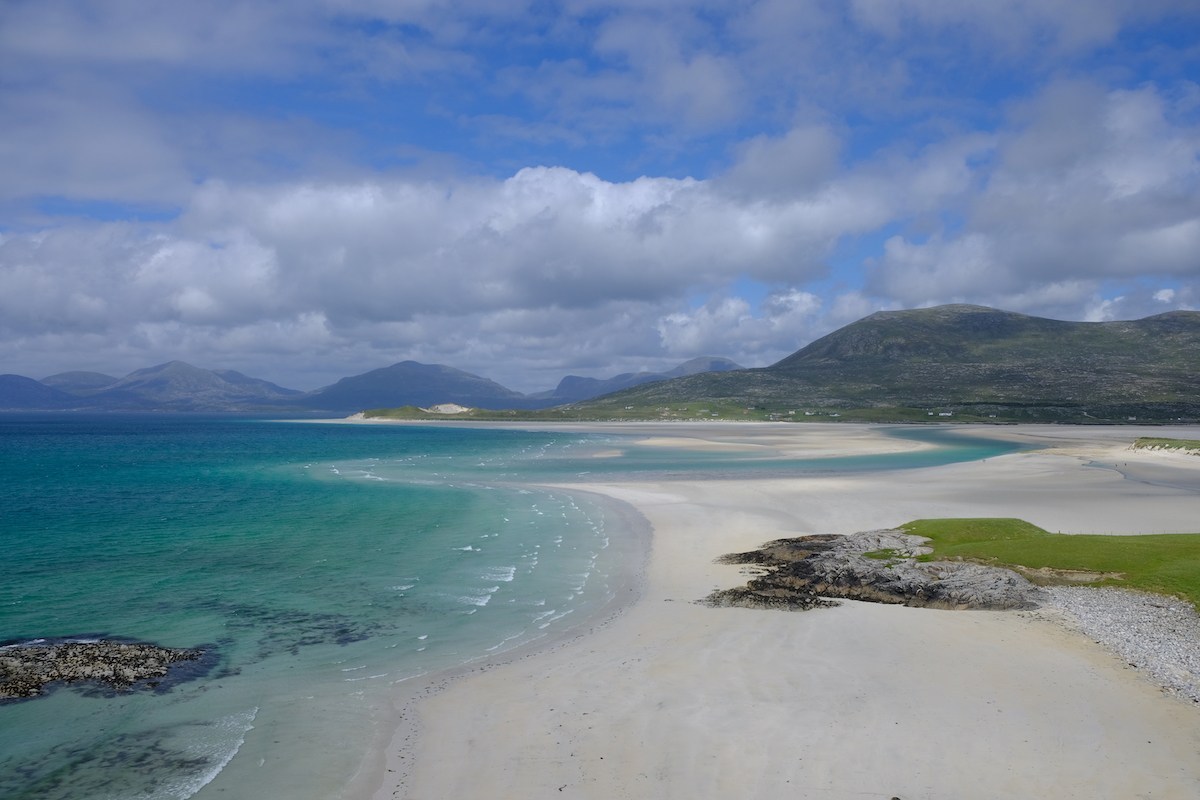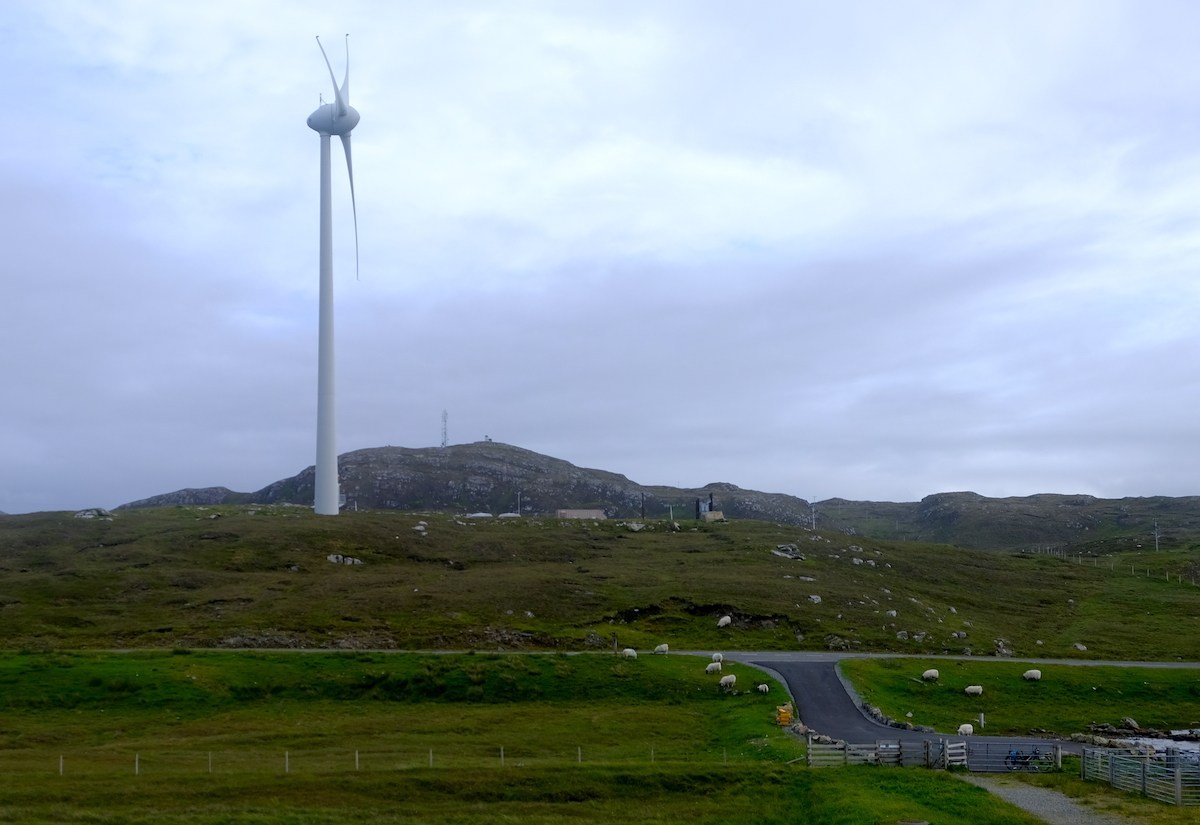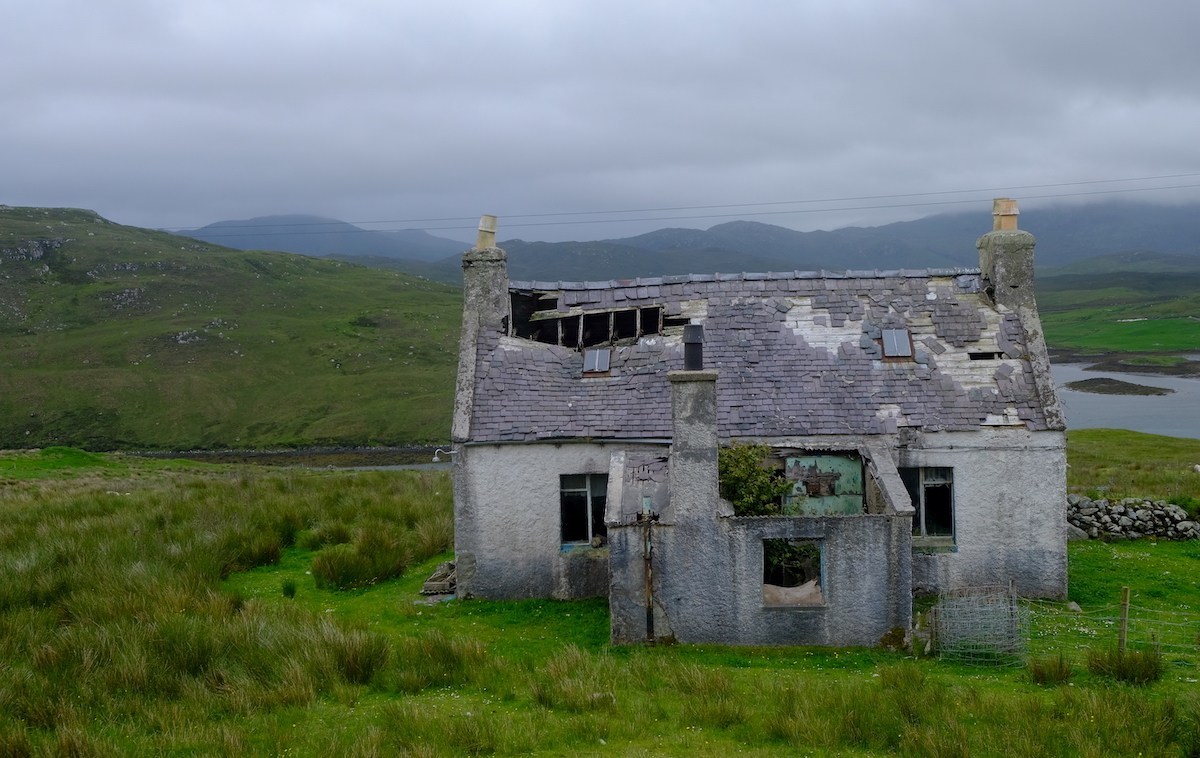How local innovation could link Scotland’s north to the Arctic
Like many Arctic regions, Orkney is remote from southern power centers. In what could become a powerful example, the sub-Arctic islands are turning that remoteness to an advantage.

Each morning before rolling out of bed, my usual routine involves checking the weather. I look at the temperature and the chance of rain. But while cycling and running across Scotland’s outlying islands last week, as I learned from my friend who has been studying at St. Andrews for three years now, it’s also important to check the wind.
Never before have I thought so much about blowing gusts of air. Before traipsing to these remote islands settled by Neolithic farmers, Picts, Celts, and Vikings over the past few millennia, I couldn’t even tell you whether a “northwesterly wind” was coming from or going towards that direction. Once I started cycling across the Outer Hebrides, though, I quickly learned that the speed and direction of the atmosphere’s huffing and puffing together make the difference between floating effortlessly uphill versus pedaling furiously to go downhill. One day on my bicycle, it took me over two and a half hours to travel 15 miles due to torturous headwinds. I could have practically run that distance in an hour less.
After my five-day cycle trip, I participated in the St. Magnus Marathon in Orkney — the United Kingdom’s northernmost such race. The hard lessons from the Hebrides were reinforced by running for 26.2 miles directly into what was, in fact, a northwesterly headwind, “which is coming directly from Canada,” jested my host, the effusive Inga Burton, an Orkney native and university engagement manager for the Highlands and Islands Enterprise, Scotland’s economic and community development agency.
Those tempests, coupled with brawny muscles, are what powered Viking ships out of Norway’s fjords and across the North Atlantic to settle the islands of present-day Scotland – Orkney, Shetland, and the Hebrides – beginning in the 8th century. There were so many Vikings in the Outer Hebrides that they were known in Celtic as Innse Gall: the “Islands of the Foreigners.” Nineteenth-century author William Cook Mackenzie described the islands of Lewis and Harris as forming a “resort” of Vikings. (At the time, the word meant a frequently visited location, but given the stunning beaches, I wouldn’t be surprised if the Vikings also used the place as an actual holiday getaway.)

The wind also allowed Vikings to sail between the places they settled. The Bandamanna saga from Iceland, which takes place sometime after the year 1000 AD, recounts the voyage of a young man named Oddr, who, thanks to favorable winds, is able to sail all the way from Iceland to Orkney to collect malt and grains (corn) for a wedding feast without having to hardly lift a finger:
“And as soon as they came outside the firth, the wind stood fast and fair; nor had they to shift a sail until they came to Orkney, where Oddr bought both malt and corn, and having dwelt there for a while, made the ship ready for sea again.”
From filling the sails to spinning the turbines
If wind allowed 11th-century Vikings to gather all the ingredients they needed for a good party, it’s now breathing new life into the economy of their 21st-century descendants (and maybe allowing them to throw a good ceilidh — Scottish country dance party — or two).
In the waters around Orkney, the wind spits up waves up to 80 feet tall that lure masochistic surfers into the frigid waters of Skail Bay and Marwick and power what are called “wave farms” on the island group’s western shores. Here, the waves — sometimes having traveled across the ocean from as far away as Newfoundland — have long enough “fetch” that they can generate thousands of megawatts of energy.
According to a study in 2017 published in Renewable Energy, the Pentland Firth, the treacherous stretch of waters separating Orkney from mainland Scotland, can generate between 2-8 gigawatts of electricity. Peak electricity demand in the United Kingdom lies between 50-60 gigawatts, meaning that wave and tidal energy here could potentially supply almost a fifth of the country’s electricity needs under optimal conditions.
The swells created also have the reliability that the wind power industry requires for their balance sheets. The European Marine Energy Centre, EMEC, established in 2003, describes the waters around Orkney as having an “excellent oceanic wave regime.” EMEC has open-sea testing facilities and more marine energy converters operational than anywhere else on earth. The wind and waves are even so strong that during a storm in August 2016, they blew a 17,000-ton oil rig off its towline, leading it to wash up on a sandy beach on the Isle of Lewis — the very same island where the Lewis Chessmen were found nearly 200 years ago.
While driving around Orkney with my host, Inga, she noted that Orkney is home to “farmers who fish.” Shetland, in contrast, is home to “fishermen who farm.” The ample plots of land around Orkney and relatively milder climate has historically made farming and crofting (raising sheep) the economy’s bread and butter, while fishing provided a little extra bonus. The reverse was true in Shetland. In Orkney, the island group’s weather-worn soil tillers are now reaping the harvests of wind farming, too, both on land and at sea.
Across the glacially carved landscape, the wind spins the heavy blades of huge turbines. These devices — lodestones for proponents of renewable energy; death traps for swooping golden eagles and migrating Arctic terns — are scattered across Scotland’s islands from Unst, Shetland’s northernmost island, to Vatersay, the Hebrides’ southernmost one.
Wind turbines look silent from afar, but at one point while nearing the end of a 70-mile day at one point along the A858 that runs along the western edge of the Isle of Lewis — a silver streak that runs across a landscape lunar enough that it passed for Jupiter during filming for 2001: A Space Odyssey — I found myself standing directly across from one. I was immersed in a surround-sound system of a methodically thumping and whooshing turbine, howling winds, and bleating sheep.

Excess electricity: Too much of a good thing
A major issue with generating so much wind power, is, of course, storage. Orkney, which once relied entirely on coal and oil imported from the Scottish mainland, generates enough electricity to meet the equivalent of 120 percent of its power needs. Unable to export the surplus to the mainland as the existing subsea cable, originally designed to deliver electricity to Orkney, simply doesn’t have the capacity for that, Orcadians, as locals are known, are considering three solutions to use up the surplus electrons. Self-described “ethnographer of futures” Laura Watts details these possibilities in her engrossing book, Energy at the End of the World: An Orkney Islands Saga. The first is to use more power on the islands, the second is to build another cable, and the third is to convert the energy into something storable, such as hydrogen.
That first of those three possible answers, increasing local electricity demand, could be achieved by increasing adoption of electric vehicles, which have decent-sized batteries. Many farmsteads have their own individual wind turbine, which could be used to not only provide electricity for their residence, but also for their vehicles, which could charge overnight at a cost of just £2-3. Inga told me of one fellow who had moved up from the Mainland after hearing of how renewable energy has taken off in Orkney, creating a sizable new market for electric vehicles. Perhaps if he has his way, next to every flock of sheep would be a Nissan Leaf.
Orkney: a model for remote communities?
It’s this kind of innovative mentality that makes Orkney a potential model for other peripheral northern communities seeking to bolster their resilience. Orkney’s local government prides itself on building a “reputation as a forward thinking island community that is able to attract funding for and deliver a range of projects with global significance.” As an example of one of those projects, last year, Microsoft opened a data center on the seafloor off Orkney that runs off EMEC’s tidal- and wave-generated energy.
As many southern capitals focus on creating the economic conditions necessary for global cities to grow — places like London, New York, or San Francisco — they neglect the fringes of national territories. Over a delightful slice of sunshine-yellow lemon cake tempered by a sharp cup of coffee, I spoke with James Stockan, leader of the Orkney Islands Council. He noted that the problem isn’t getting London to listen — it’s getting them on the phone in the first place.
Ignored by their metropoles, for people living in remote locations, the choice for how to succeed economically can often hinge between rolling up the sleeves and digging in for the long haul or out-migrating.
I was struck by the difference between Orkney, where people seem to be feverishly innovating and looking for local solutions, and the desolate Hebrides, where I passed one abandoned farmstead after another. A few people I spoke to in Orkney described that these divergent trajectories were due to a combination of a difference in local attitudes and a more diverse economy in Orkney. The Hebrides, whose economy is largely driven by the public sector, also are much more remote: Mainland Scotland is at least two hours away by ferry, while the shortest ferry between Orkney and the top of Britain, John O’Groats, takes only 45 minutes.

(Br)exit through the Arctic
With the right attitude, however, remoteness can be reframed into centrality. Orkney, and Scotland at large, aim to capitalize on their historic northern linkages both offensively, to take advantage of the economic opportunities opening in the Arctic thanks to climate change and globalization, and defensively, to provide the country with an alternative regional outlook should Brexit come to pass. Stockan, the Orkney Council leader, said that positioning Orkney in the Arctic “makes sense.” In his view, Orkney shouldn’t be a backdoor to the Arctic, but rather a gateway, as it long has been for everyone from Viking marauders to British polar explorers and Hudson’s Bay Company employees, many of whom hailed from Orkney.
In September 2019, the Scottish Government is planning to release its Arctic strategy. The launch will likely take place in Stromness, Orkney’s second city, not far from the well where the ships of Captain Cook, John Franklin, and Arctic explorer John Rae — an Orcadian who supposedly discovered the final “missing link” of the Northwest Passage — all drew fresh water. A more official release of the policy may occur at the annual Arctic Circle conference in Iceland in October, three years after Scottish Premier Nicola Sturgeon addressed the gathering in Reykjavik.
Repositioning Orkney within a wider Arctic community makes further sense considering that Orkney was Norse for longer than it has been British. If the year 875 AD is taken as a starting point for the official rule by the Norse, when Harold Hårfagre (“Fair Hair”), the first King of Norway, defeated Viking raiders and established rule over Orkney, and extended up until 1468, when the islands passed into the Kingdom of Scotland as collateral to back up a failed dowry payment, then the Norse were in charge for 593 years.
The Scottish have been in charge for only 551 years, and the British for even less time than that.
If the United Kingdom breaks up as a result of Brexit — a real risk run by a “no-deal” outcome, as Prime Minister Theresa May’s cabinet was warned last week — Orkney, which voted heavily to remain in the European Union, will undoubtedly be in a difficult position. The EU has helped finance ranging from the large-scale EMEC project to a community hall on the island of Burray, home to 409 people.
In the 2014 Scottish independence referendum, Orkney also voted strongly to remain within the UK. Of all Scottish councils, Orkney had the lowest percentage of voters in support of breaking away. Just 32 percent of people wanted the country of haggis and Harris tweed to be independent from Westminster.
Perhaps having changed hands so many times, Orkney may seek some stability in its politics. Whichever way the wind blows, though, at least for now, the islands seem set to continue riding high on the waves.